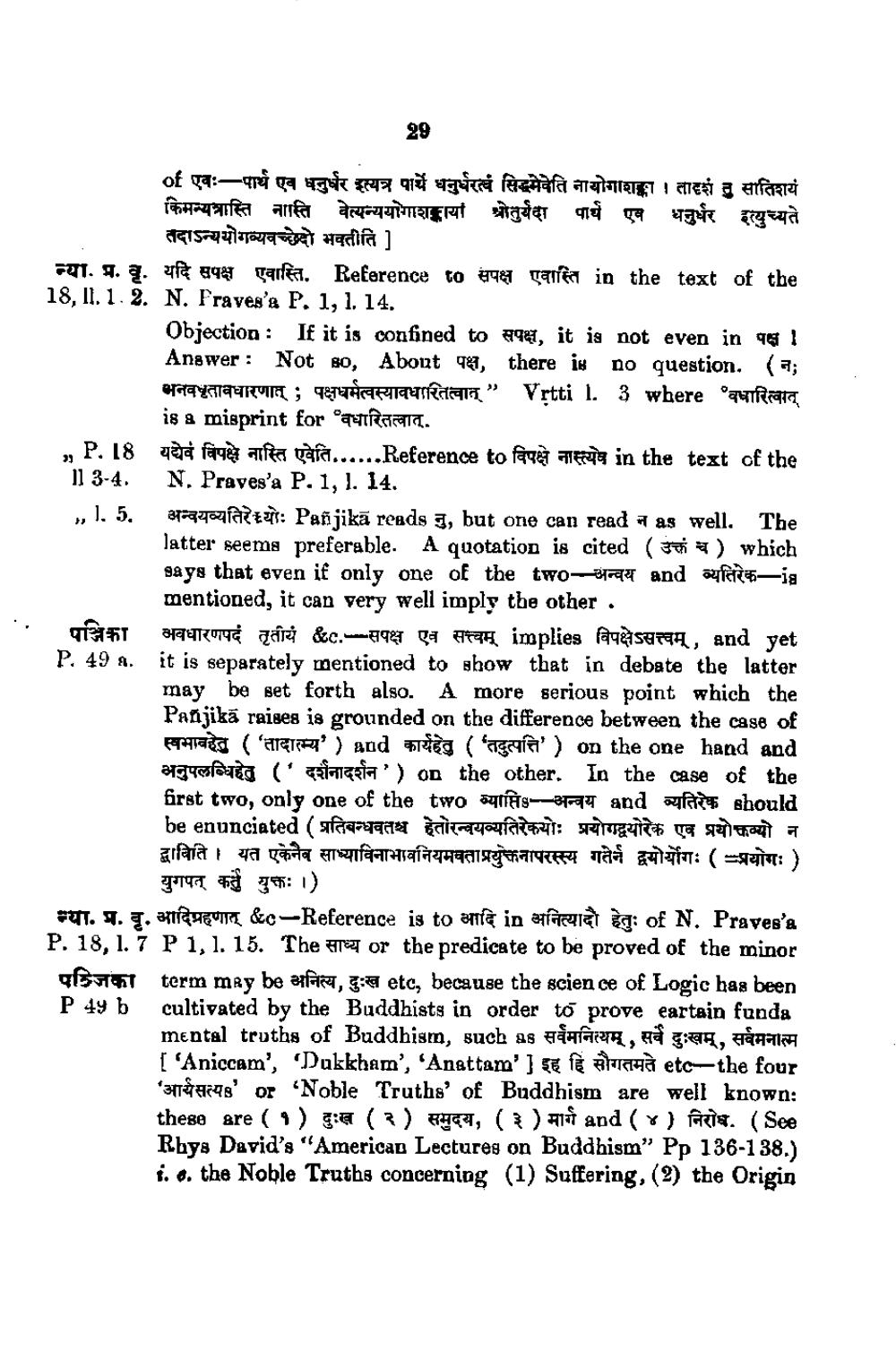________________
29
of एवः-पार्थ एव धनुर्धर इत्यत्र पार्थे धनुर्धरत्वं सिद्धमेवेति नायोगाशङ्का । तादृशं तु सातिशयं किमन्यत्रास्ति नास्ति वेत्यन्ययागाशङ्कायां श्रोतुर्यदा पार्थ एव धनुर्धर इत्युच्यते
तदाऽन्ययोगव्यवच्छेदो भवतीति ] न्या. प्र.. यदि सपक्ष एवास्ति. Reference to सपक्ष एवास्ति in the text of the 18, 1.1.2. N. Praves's P. 1,1. 14.
Objection: If it is confined to सपक्ष, it is not even in पक्ष! Answer : Not so, About पक्ष, there is no question. (न; भनवधूतावधारणात् ; पक्षधर्मत्वस्यावधारितत्वात् ” Vrtti l. 3 where 'वधारित्वात्
is a misprint for "वधारितत्वात्. , P. 18 यद्येवं विपक्षे नास्ति एवेति......Reference to विपक्षे नास्त्येव in the text of the ]] 3-4. N. Praves'a P.1, 1. 14. , 1. 5. अन्वयव्यतिरेयोः Palijika reads नु, but one can read न as well. The
latter seems preferable. A quotation is cited ( उक्तं च ) which says that even if only one of the two-अन्वय and व्यतिरेक-ia
mentioned, it can very well imply the other. - पत्रिका अवधारणपदं तृतीयं &c.-सपक्ष एव सत्त्वम् implies विपक्षेऽसत्त्वम् , and yet P. 49 . it is separately mentioned to show that in debate the latter
may be set forth also. A more serious point which the Panjikā raises is grounded on the difference between the case of स्वभावहेतु ('तादात्म्य' ) and कार्यहेतु ('तदुत्पत्ति' ) on the one hand and अनुपलब्धिहेतु (' दर्शनादर्शन') on the other. In the case of the first two, only one of the two व्याप्ति-अन्वय and व्यतिरेक should be enunciated (प्रतिबन्धवतश्च हेतोरन्वयव्यतिरेकयोः प्रयोगद्वयोरेक एव प्रयोक्तव्यो न द्वाविति । यत एकेनैव साध्याविनाभावनियमवताप्रयुक्तनापरस्स्य गतेन द्वयोर्योगः (=प्रयोगः )
युगपत् कर्वे युक्तः ।) न्या. प्र. वृ. आदिग्रहणात् &c-Reference is to आदि in अनित्यादौ हेतुः of N. Praves'a P. 18,l. 7 P 1, 1. 15. The साध्य or the predicate to be proved of the minor परिजका term may be अनित्य, दुःख etc, because the science of Logic has been P 49 b cultivated by the Buddhists in order to prove eartain funda
mental truths of Buddhism, such as सर्वमनित्यम् , सवें दुःखम् , सर्वमनात्म [ 'Aniccam', 'Dukkham', 'Anattam' ] इह हि सौगतमते etc-the four 'आर्यसत्य' or 'Noble Truths' of Buddhism are well known: these are (१) दुःख (२) समुदय, (३) मार्ग and ( ४ ) निरोध. (See Rhys David's "American Lectures on Buddhism" Pp 136-138.) i. e. the Noble Truths concerning (1) Suffering, (2) the Origin




